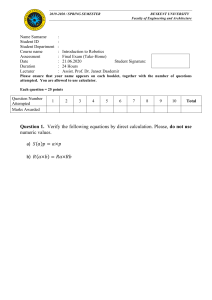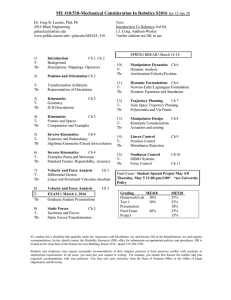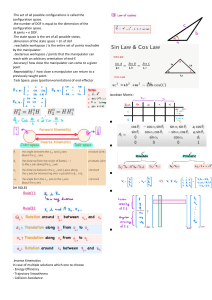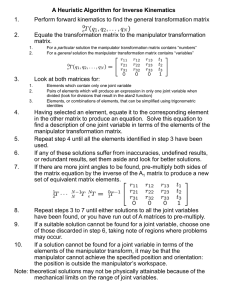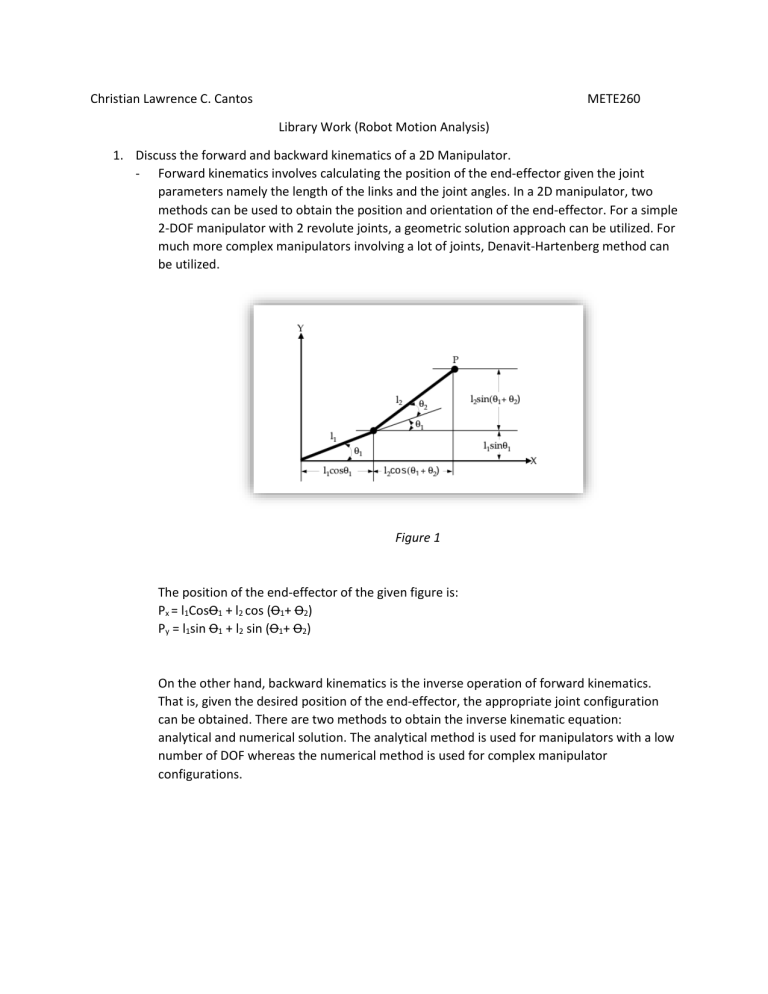
Christian Lawrence C. Cantos METE260 Library Work (Robot Motion Analysis) 1. Discuss the forward and backward kinematics of a 2D Manipulator. - Forward kinematics involves calculating the position of the end-effector given the joint parameters namely the length of the links and the joint angles. In a 2D manipulator, two methods can be used to obtain the position and orientation of the end-effector. For a simple 2-DOF manipulator with 2 revolute joints, a geometric solution approach can be utilized. For much more complex manipulators involving a lot of joints, Denavit-Hartenberg method can be utilized. Figure 1 The position of the end-effector of the given figure is: Px = l1CosꝊ1 + l2 cos (Ꝋ1+ Ꝋ2) Py = l1sin Ꝋ1 + l2 sin (Ꝋ1+ Ꝋ2) On the other hand, backward kinematics is the inverse operation of forward kinematics. That is, given the desired position of the end-effector, the appropriate joint configuration can be obtained. There are two methods to obtain the inverse kinematic equation: analytical and numerical solution. The analytical method is used for manipulators with a low number of DOF whereas the numerical method is used for complex manipulator configurations. Based on figure 1, the inverse kinematic equation used is: 2. Discuss the forward and backward kinematics of a 3D Manipulator. - The forward and backward kinematics of a 3D manipulator used the same approach as a 2D manipulator, but the z-axis must be taken into consideration when doing calculations. For a 3D manipulator with two revolute joints, the forward kinematics equation is: Px = l2cosꝊ1 cosꝊ2+ l3 cosꝊ1cos (Ꝋ2+ Ꝋ3) Py = l2sinꝊ1 cosꝊ2+ l3 sinꝊ1cos (Ꝋ2+ Ꝋ3) Pz = l1+ l2cosꝊ2 + l3 cosꝊ1cos (Ꝋ2+ Ꝋ3) 3. Differentiate the kinematics motion analysis of a 2D and 3D Manipulator. - The forward and backward kinematic equation of a 2D compared to the 3D Manipulator is much simpler. For a much more complex 3D manipulator, the equation in item no. 2 can’t be used. Instead, Transformation matrices are applied. A numerical method is utilized when dealing with 3D manipulators since there is no single approach that would describe the configuration of the manipulator. That is, the equation involves a lot of solutions. Hence complex manipulator configurations require a computer to obtain the equation both for the forward and backward kinematic equation. 4. Explain Denavit-Hatenberg Convention in Kinematics. - DH Convention in kinematics is a convention where each joint of the manipulator is breakdown into four parameters, which each are taken with reference to the previous joint. The 4 parameters are namely: 1. Distance between the previous and the current x-axis, along the previous z-axis. 2. The angle around the z-axis between the previous and current x-axis. 3. The distance between the previous and current z-axis, which is also called the common normal. 4. The angle between the previous and current z-axis and the common normal.
